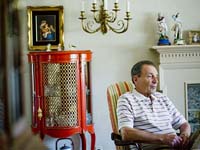Hans’ Story
At the age of 69, Hans was a healthy and active retiree. When he began feeling the need to urinate more frequently, he visited an urologist, who found that Hans’s prostate was enlarged and his PSA levels were elevated. When Memorial Sloan Kettering doctors gave him a choice between surgery and radiation, Hans opted for brachytherapy, a technique in which radioactive seeds are implanted in the prostate and high doses of radiation are delivered directly to the tumor.

Hans A. Schicht
During one of my regular checkups, after coming back to our Garden City, New York, home from our winter home in Florida, my doctor suggested that, because of my age, I see a urologist. Just before this, for the first time in my life, I had begun to experience frequent urination issues, during which I would have to get up five times a night to urinate. The urologist did a digital rectal exam, which revealed that my prostate was enlarged. A biopsy and a blood test were performed. The results of the blood test showed that I had a PSA of nearly 5, and after the biopsy it was confirmed that I had prostate cancer.
This Isn’t a Sore Throat
My urologist broke the news to me in a very nonchalant manner, saying there was nothing much to worry about because the cancer was localized on one side of my prostate and that it had not spread beyond its borders. When I returned home from that visit, something about his off-handedness bothered me. I thought, “This isn’t a sore throat or a broken thumb. It’s cancer.” As a man, you go through your entire life taking care of other people and things — your wife, your children, your job, your home. Now, I realized I would have to take care of myself.
When I was considering hospitals, one of my tennis player friends, Mortimer Chute, the former and now retired Memorial Sloan Kettering Senior Vice President for Development, recommended that I go to Memorial Sloan Kettering for my treatment. He told me to see Dr. Michael Zelefsky, who, according to my friend, was one of the best prostate doctors in the world.
At my first appointment, I was overwhelmed by his attentiveness. I asked him a long list of questions, and he answered each one in great detail. He pointed out to me that every patient at Memorial Sloan Kettering gets treated not just by one doctor, but by a team of doctors, all working together on the case. He asked that I have all of my diagnostic tests redone at Memorial, so that Memorial’s team of experts could look more closely into the details of my cancer.
I told Dr. Zelefsky, “I’m going to ask you all of these questions, and when I’m finished I am going to open my arms and say, ’Take care of me.’” I am that type of person. Once I’ve made my mind up to go with one person, I will do whatever it is he says to do.
Two Treatment Choices
I was given two main treatment choices: One was to have the prostate removed surgically; the other was to have radiation seeds implanted, a treatment known as brachytherapy. Brachytherapy is a form of radiation therapy in which radioactive seeds are implanted into the prostate, where they deliver high doses of radiation directly to the tumor.
In doing my own Internet research and in talking with Dr. Zelefsky, I learned that while the general success rate for seed implant is approximately 80 percent, the success rate for the procedure when done at Memorial Sloan Kettering is about 90 percent. I appreciated that he was talking frankly with me, but at the same time talking to me as if he knew me personally, which, for me, made a heck of a difference. I needed a certain amount of information to feel satisfied with my decision, and he gave me that.

Hans Schicht
I decided that brachytherapy would be the most effective choice, considering its minimal impact on the rest of my life. I felt confident that Dr. Zelefsky would take care of me. On some level, I already felt as if I was cured. With this decision made, I went in for the implant procedure in August 2004. It was a relatively simple procedure, at least from a patient’s perspective, and I was able to return home the same day. I experienced no pain at all as a result of the treatment.
Additional Radiation Treatments
Having reviewed all the redone test and scan results, which showed two large areas of tumor on one side of my prostate, Dr. Zelefsky recommended that I also undergo traditional external beam radiation therapy. This process lasted six weeks and required me to go in for radiation treatments on a daily basis, Monday through Friday, with weekends off. The treatments themselves only took about 15 minutes.
I continued to play tennis throughout the radiation treatments, though I was noticeably weaker and more easily fatigued for the first three or four months. It bothered me enough that I asked Dr. Zelefsky about it at one of my appointments. He told me that the fatigue could last up to a year, but that I would eventually regain my strength. He said I also needed to take into account my age. Even without cancer, at my age you start naturally to lose some strength and stamina that you may have had just a couple of years earlier.
In terms of other, more serious potential side effects, such as urinary or bowel problems, I was fortunate not to experience any of them.
Advice to Others — Don’t Wait
My advice to other men is simple. If you feel sick, see your doctor. Prostate cancer is not the sort of thing that you can just ignore and it will go away. For men my age, it is definitely worthwhile to investigate any potential prostate problems. If you are diagnosed with prostate cancer, I believe you should look for both the best possible doctor and the best possible hospital for treatment.
For me, there was really no question that Memorial Sloan Kettering was the place to go. Once I made that decision, 50 percent of all the other uncertainty was erased. And when I met Dr. Zelefsky, I knew that this was the man who would cure me. Seeking a second opinion is very important, but once you’ve received all the information then a choice must be made to move forward. Once you choose the right doctor and hospital, everything that follows becomes much easier.
